
Soft Spot
Reviews: 16 New Carts for the VCS
The great TV-game wars have begun, though unlike the geopolitical landscape only one superpower has emerged: Atari. No doubt this is because there are more Atari Video Computer Systems (VCS) in American homes then all of the other game systems combined. But, ultimately, Atari’s unparalleled success may be its own undoing. Like they say on Wall Street, the razor’s always going to need new blades, and Activision, Imagic and a host of other software-only upstarts will be more than willing to provide them.
Ever since Activision opened the floodgates in 1980 a tidal wave of companies has appeared with cartridges for the VCS. In this intense competition, only those producing the strongest products at the best price will survive. In the final analysis, the consumer stands to gain the most—imaginative, quality games.












































Planet Patrol
Gangster Alley
The Empire Strikes Back
Frogger
Frog Pond
Megamania
Demons to Diamonds
Pitfall
Racquetball
Shark Attack
Lost Luggage
Atlantis
Cosmic Ark
Astroblast
Space Attack
Another point is no longer does a company need millions of dollars to join in the fray. Thousands, apparently, will do. Ironically, Comma-Vid, probably the tiniest company in the business, has released as is debut the largest cartride I have ever seen. Cosmic Swarm must have everything in it but the kitchen sink. In this Asteroids-type game, you move your ship in any direction, and you can rotate it by pressing the red button on the Atari joystick. In fact, this ship moves more precisely than the one in Asteroids, which is just the edge you need to go up against The Swarm. These termite-type characters which most resemble Chinese letters try to wall in the playing field by dropping blocks everywhere they go. Destroy them before they box you in by blasting away whenever they’re carrying their blocks. This will do away with both the termite and his block simultaneously. If, however, you can’t spray the little bugger before it drops its block, you can still earn points for shooting the termite as it escapes.
Once the blocks are set in place and turn green, they’re indestructible. But nail an attacking bug where that green block is and suddenly it becomes red and is vulnerable again. Meanwhile, to make things even more complicated, you have to refuel every time you hear the warning signal by docking with one of the ships cruising along the side of the screen. If you can’t make it, you lose the game immediately. Phew!
Graphically, Cosmic Swarm is pretty unappealing unless you’re into Chinese literature. But it does provide an action-filled, challenging scenario with plenty to keep you occupied. It’s about as tough as any game I’ve played this side of the arcades.
Spectravision, another rising star in the TV-game galaxy, certainly backs up its corporate slogan (“Meets the challenge”) with two entertaining entries, Planet Patrol and Gangster Alley. A difficult-to-master dodge-‘em and shoot-‘em-up game, Planet Patrol has some interesting variations, including sequences with exploding debris, a rescue operation and a petrol stop courtesy of a cute miniature truck. There’s also an exciting night-flying round where your adversaries are illuminated with just the light from your laser cannons. Planet Patrol is aces.
In Gangster Alley, you use a cursor—as in Missile Command—to line up your foes. Though it’s no Missile Command, Gangster Alley does have its charms. The object is to vanquish a nasty group of armed hoods whose heads keep popping up in the windows of a tenement-type building. Aim with the joystick and fire with the button before they shoot you. It’s pretty easy until you encounter Nitro Ed. That’s the maniac standing on the roof waving a bomb. You see, Ed can’t be killed by a hit, just disarmed momentarily. Plus, if he wastes you, it’s game-time. The final insult is a full-screen image of Ed laughing at you. Very funny. While I found Gangster Alley too much work for my worn reflexes, I suspect that the younger generation of gamers will have little trouble handling these electronic nogoodniks.
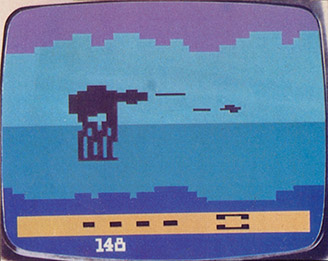
Now, let’s get on to the big boys. Parker Brothers, the company that made “Pass Go—Collect $200” a household phrase, would seem to have a sure bet with the first-ever, film-as-video-game creation, The Empire Strikes Back. I wouldn’t bet on it.
An obvious Defender rip-off, the object here is to destroy several Imperial Walkers before they blow up your base. To obliterate one of these lumbering behemoths, you have to shoot it 48 times while avoiding the missiles they periodically lob at you. Boring! Fortunately, the game does have a few neat tricks, like when the colored square appears on the Walker (hit it once and watch the Walker go bye-bye), the automatic repair gimmick (land your damaged vehicle in a valley on planet’s surface), and “The Force” (momentary invulnerability). But that’s all there is. Empire is a dull, ill-conceived game that just happens to have a famous name.
Frogger fans take heart, though. Parker Brothers has admirably fulfilled your need for a suitable TV version of the popular arcade game. Not only does Parker’s Frogger look and sound like the coin-op hit, it plays like it, too. Following the nifty little tune that is Frogger’s trademark, you begin navigating the intrepid amphibian across a treacherous playing field. I never could understand the popularity of this slow-moving, rather simple-minded game, but if hopping and squishing is your thing, Frogger is sure to delight.
Frogs seem to be “in” this year. Atari (who?) has just released its variation on the frog theme called Frog Pond. As beautiful as Frog Pond looks, that’s how dull it plays. Two silhouetted creatures, who do indeed look like frogs, sit on what appears to be a log in an aquamarine video lake, doing what frogs are supposed to do: hop up and down and snatch insects with their whip-like tongues. This may be an enjoyable as well as nourishing way for a frog to spend its day, but I’m afraid frogs catching flies for points is a less than appetizing human divertissement. Ribid.
Atari breaks even less ground with another new offering called Demons to Diamonds. This game involves shooting an assortment of little creatures (what else is new?) with the paddle control. The demons that are the same color as you can’t shoot you but do reincarnate briefly as diamonds, which, when hit, are worth a bonus. The demons that are a different color than you transform into skulls and start firing back when they are hit. Demons is dumb, plus the graphics are inferior. The giant of the industry has produced another dwarf.
And what were the boys at Activision—who ignited the cartridge explosion with clever games and superior graphics—thinking when they came up with Megamania? A gastronomical farce of sorts in which fast foods such as hamburgers and waffles march top to bottom, Megamania is one more example of Activision’s sillier side (see Freeway and Fishing Derby). But is it fun to play? Next cartridge.
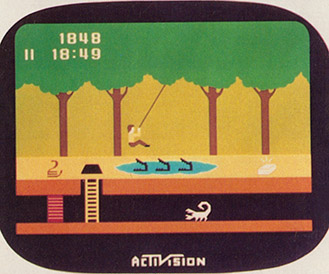
Activision, however, redeems itself with Pitfall, a game that combines all the necessary ingredients for a sure-fire hit. The idea is to guide a human figure through treacherous terrain by having him run and jump over obstacles much like Mario does in Donkey Kong. The similarity to DK ends there, though, for Pitfall is about crocodiles, scorpions, underground caverns and lost treasure, not an ape and a girl. There’s even a sequence where our hero must catch a vine and swing perilously over the pit like an electronic Tarzan. The graphics are clean, colorful and innovative. But is Pitfall fun to play? Definitely.
Historically, sports games have not translated particularly well on the VCS. Except for Activision’s wonderful Tennis cartridge and possibly Atari’s Basketball, realism has been seriously lacking—from Pele’s Soccer to Home Run baseball. Still, you have to credit Apollo (of Space Chase and Space Cavern fame) for giving it the old college try with Racquetball—even if it is a mess. The court looks like something involving concentric parallelograms out of a high school geometry textbook; when the two players cross each other, not only can’t you decide which player is which, but you can’t figure out whose turn it is; and since the ball and its shadow are both represented by white cubes you never know if you’re making contact with the ball or hitting a phantom. (There’s even a third cube bouncing around the court—damned if I know what it’s doing there.) Perhaps some games should be left on the court and off the tube.
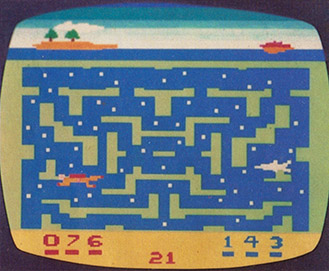
The good news for Apollo is Shark Attack, a maze game that has some novel twists and clever graphics. As a scuba diver whose goal is to gather up diamonds scattered around an underwater maze, you must steer clear of ravenous sharks and a dormant Loch Ness monster who, when disturbed, relentlessly pursues the offending diver and can only be eluded if the diver enters one of the mysterious caves. Shark Attack or Loch Jaw, as it was formerly and more aptly titled, may be the first maze game that is not a conspicuous Pac-man rip-off, and for that alone I offer kudos to the people at Apollo. It also happens to be fun to play and great to look at. Bravo!
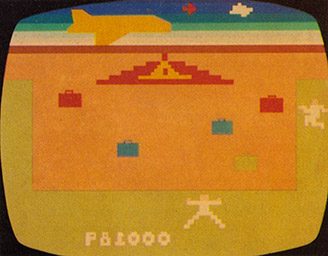
Returning to the bad news, there is Lost Luggage, also by Apollo, which is a fairly obvious clone of Activision’s successful Kaboom cartridge. Here, instead of catching bombs released by a mad man, you flag down suitcases spinning wildly off an airport luggage carousel. The two games are so alike that some suitcases are even marked as terrorists’ bags that, lo and behold, blow up if not caught in much the same manner as the Kaboom bombs. I’ve always felt that Kaboom—not much of a game in my opinion—was a hit solely because of the dearth of TV-game competition when it came out. Back then (1980), you didn’t expect much and you got even less, whereas today a game that involves catching suitcases before they explode—even if they do release a flood of electronic underwear—just doesn’t wash.
While one-out-of-three ain’t too bad in Apollo’s case, Imagic continues to bat 1.000. I don’t know what Imagic’s secret is, but if I could bottle it I’d make a fortune. This company consistently comes up with winners. Demon Attack and Star Voyager already have set the standards in their respective game forms: the post-Space Invaders and Star Raiders themes. The company’s latest arrivals are equally as impressive.
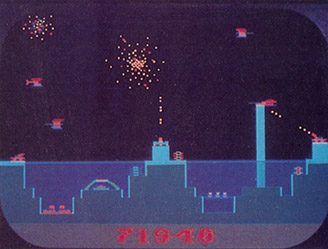
Graphically, Atlantis has no peer. What you see on the screen when you plug in the cartridge can only be described as dazzling. Before you lies the stunning, futuristic city of Atlantis, with its domed palace, multi-colored generators and laser-armed sentry posts. The object is to defend Atlantis from an insidious Gorgan air fleet. You’re armed with three anti-aircraft batteries—the one in the center of the screen is called the command post, the two at the opposite ends of the screen are the sentry posts. Since the guns are at fixed positions, timing your shots is the only way to make your hits on the enemy fleet. As it descends, the spectacular, colorful bombers—hit one and it explodes like fireworks—emit death rays with accompanying sound effects that are right out of a Grade A science fiction movie. So much attention is paid to detail that even after the city is destroyed, a satellite streaks into space leaving it up to the imagination whether someone has survived to carry forth the civilization into a new world. Atlantis is just a terrific game that keeps you glued to your joystick.
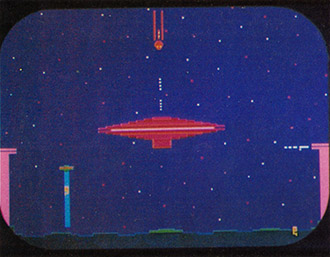
It’s pretty hard to top Atlantis, and Imagic’s other new entry, Cosmic Ark, is no threat. Even so, this game stands very well on its own merit. In Cosmic Ark, it’s your job to save species of animals from dying planets by beaming them up via your shuttle ships and then piloting the shuttles back to your starship—a kind of galactic Noah’s Ark—within a limited time span. You have. to contend with meteor showers, elusive creatures, and planetary defense systems bent on thwarting your cosmic mercy mission. Cosmic Ark may not be the average video warrior’s cup of tea, but it deserves high marks for originality and its humanitarian theme of saving rather than destroying.
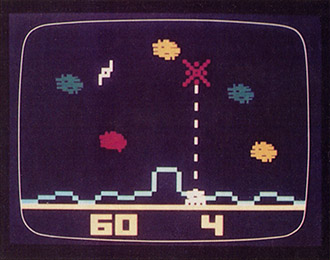
With all of these companies clawing for every last dollar vcs owners have budgeted for new cartridge purchases, did you really believe Mattel would sit passively forever? Strange as it may seem, the maker of Intellivision is now also producing software for its arch-rival. Titled the “M Network,” the results so far are commendable. Astrosmash, one of Mattel’s bonafide hits, has been rechristened Astroblast for the series and, fortunately, it hasn’t lost much in the conversion. One of the better post-Space Invaders variations, Astroblast requires you to fend off a barrage of falling objects including rocks, spinners, pulsars and UFOs. In this version, you have the option of using a paddle controller, which gives you a much faster response, and rapid-fire. Both make play easier and far more enjoyable. Astroblast is a simple concept that happens to be a lot of fun to play. Let’s hear it for simplicity.
Space Attack is a welcome addition to the first-person space war genre, even though the three-dimensional effects are rather weak. Only the enemy’s fire has depth; the ships remain the same size throughout the battle. Space Attack has some sophisticated tricks up its sleeve, however. As with its cousin, Space Battle, you get to plot your defensive strategy on a radar map and choose which of your three squadrons will be used in combat. After that’s decided, it’s off to the intergalactic wars in whatever sector you wish to defend. When one of the enemy fleets closes in on the mothership, a warning siren lets you know you’re in trouble and should fight back immediately. Space Attack is a challenging and enjoyable game with fine graphics, but I’m afraid it just doesn’t measure up to the state-of-the-art standards set by Activision’s Starmaster or Imagic’s Star Voyager.
One final point: I strongly disagree with the notion that hit movies should automatically translate into video games. I say this because shortly there will indeed be an abundance of movie-titled games—Atari’s Raiders of the Lost Ark, to name just one. This kind of logic escapes me. Except for the instant recognition factor, I can’t see how the numerous intricacies that make a multi-million dollar movie successful have anything to do with the nuances that make a video game click. But who am I to judge? Twenty years ago, when I was asked to invest in Xerox, I said, “Who in his right mind would spend a thousand dollars on a copying machine when, for two bucks, you can buy a box of carbon paper?”
Source Pages







